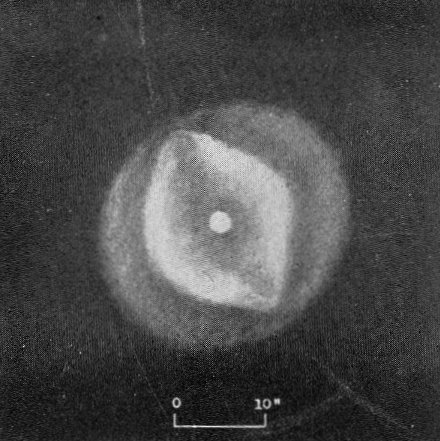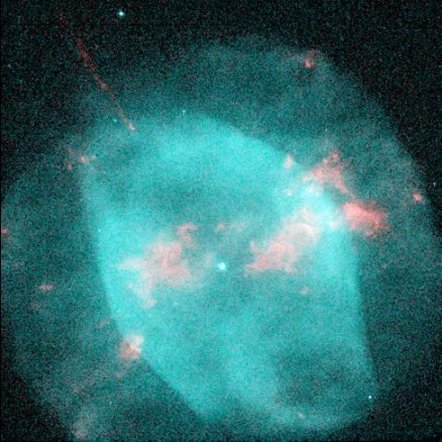NGC 7354
On NGC 7354: "A somewhat irregular oval ring, fading out at each
end, 22" X 18"... Outside of this is a ring of much fainter
matter, rather more circular and 32" across...Relatively faint."
(Curtis). He is describing a classic "double shell" nebula rather
similar to better-known NGC 3242 or NGC 7662, the form shaped by winds from the
central star. NGC 7354, in southeastern Cepheus 3.2 degrees north-northeast of the famed
variable star Delta Cephei, remains
somewhat mysterious. Not your most popular nebula, it carries no
proper name. Part of the nebula's faintness is due to some 3.5
magnitudes of dimming by interstellar
dust. The Hubble image reveals knots of radiating gas (in red)
that lie in a ragged line perpendicular to the inner oval's minor axis
and a faint jet in the upper left corner that lies along it.
Distance estimates are all over the place. A reasonable guess
suggests 4000 light years, but it could be smaller or larger by a
factor of two or more. If so, the inner ring is 0.4 light years
across, the outer around 0.6 light years. The expansion rate of
the inner ring of 26 kilometers per second is modest. While the
helium abundance may be up from the solar value by maybe 20
percent, that of nitrogen seems normal, so chemical enrichment
appears minimal.
At the core is a faint 16th magnitude (greater than 16.2) star with
a temperature close to 100,000 Kelvin. Given no secure distance,
there is little point in trying to estimate its luminosity, but it
is well into the thousands of Suns. The star looks faint in the
images only because the vast majority of its light is radiated in
the ultraviolet. No matter
what the true numbers are, the central star seems to be nearing the
end of its heating phase, after which it will cool and turn into a
white dwarf.
Left: Image and quote by H. D. Curtis from Publications of the Lick
Observatory, Volume 13, Part III, 1918. Right: Hubble Legacy
Archives, A. Hajian et al.



